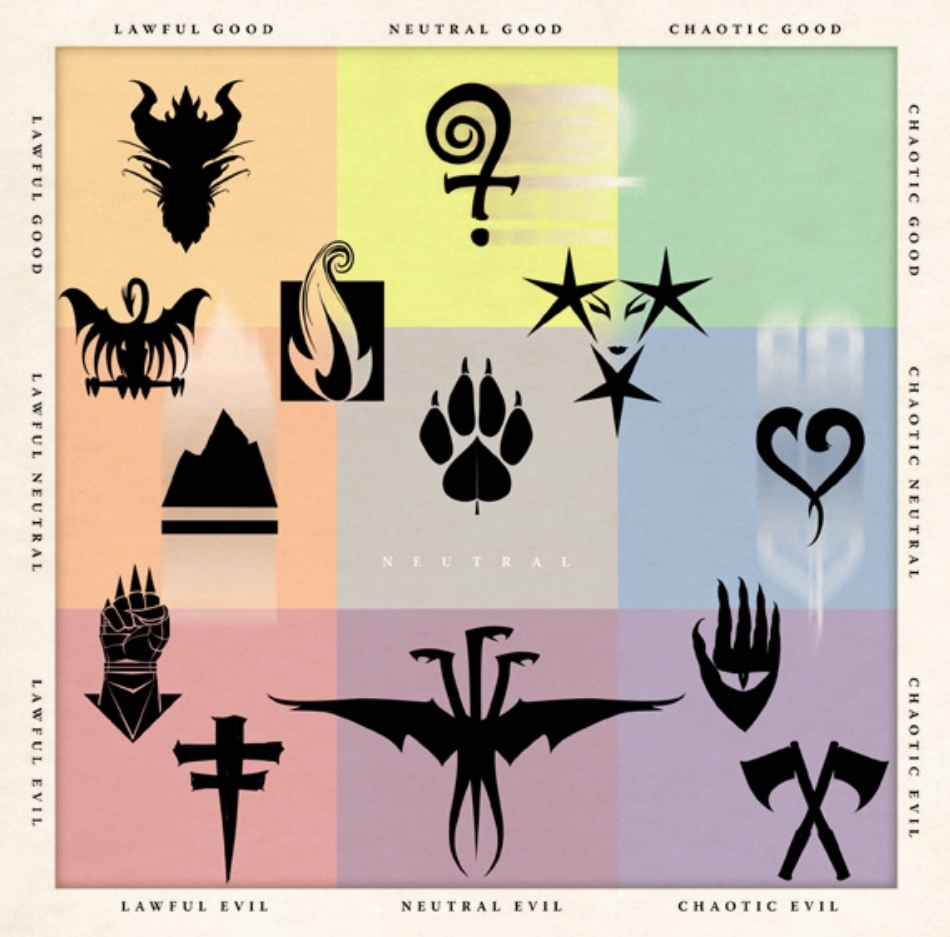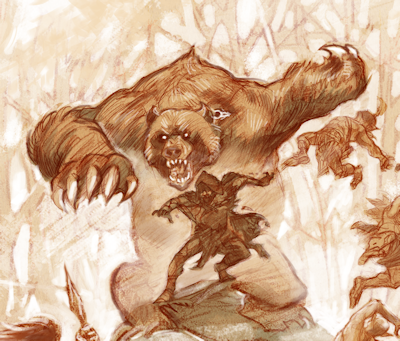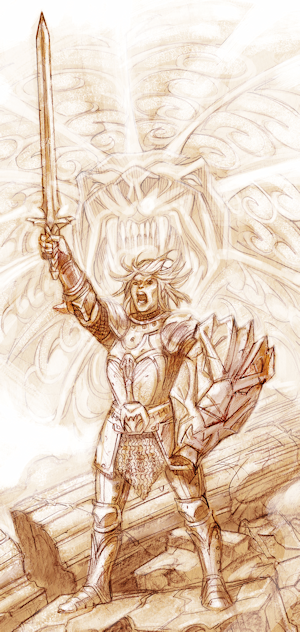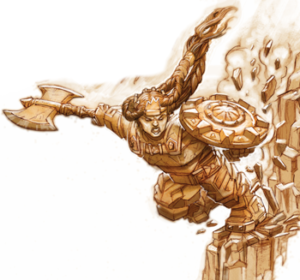Partida Rol por web
El mar estrangulador - 13th Age Asalvajado
13th Age Salvaje
- Portada
- Grupo I - Escena II: El mar estrangulador
- Grupo I - Escena I: Un equipo bueno para Nada
- Grupo II - Escena IV - Epílogo
- Grupo II - Escena III: Encontrando al Ingeniero
- Grupo II - Escena II: El mar estrangulador
- Grupo II - Escena I: El cofre del bosque muerto
- Creación de personajes
- 13th Age Salvaje
- Notas sobre mecánica de Savage Worlds en esta partida
- MrSeek
- Estado de los personajes y otras cosas
Los iconos y su mecánica de juego
13th age es un juego de fantasía épica medieval en el que los personajes son héroes de forma muy similar al concepto de Wild Cards de Savage Worlds. Adicionalmente 13th Age introduce unas mecánicas de improvisación y unas facciones para fomentar que se juegue de forma narrativa.
Es un mundo en el que unas facciones principales están en conflicto en un equilibrio tenso y precario. La idea está sacada de los 13 clanes de Vampiro La Mascarada solo que en vez de clanes vampíricos las facciones están representadas por un personaje icónico que encabeza dicha organización y que además se asimila a personajes icónicos que suele haber en mundos de fantasía medieval. Aunque no estén siempre todos, siempre hay varios de ellos: El rey enano, la reina elfa, el lich, la demonologista, el emperador, el archimago... son los arquetipos así que no hace falta que leáis nada de 13th Age sino tirar de vuestro propio bagaje de literatura fantásitica para haceros una idea de como son.
![]()
Dentro de los alineamientos clásicos del D&D algunos son legales/buenos y otros caóticos/malvados, pero es posiblea tener buenos contactos con cualquiera y así se abre la puerta a aventuras en las que los jugadores son más canallas que heróicos.

Algunos iconos se apoyan y otros están en conflicto abierto. Pero incluso los que se apoyan tienen sus diferencias por lo que el Imperio Dragón está en un equilibrio de fuerzas precario.
Los personajes empiezan distribuyendo 3 puntos 2 ptos de relación entre iconos (en 13th age son 3, pero a mí se me hace demasiado). Para cada punto tienen que decidir si es un punto de relación positiva, ambigua o negativa. Así que ya de primeras los pjs están de algún modo aliniados en un conflicto. Esta es una elección que de entrada da un tono particular a la aventura y que eligen los propios jugadores.
Lógicamente, aunque cada pj elije como quiere repartir sus puntos, es importante que todos estén en cierta consonancia igual que en cualquier otra aventura. Es decir: ¿Vamos de santos o vamos de cabrones?
- Tenéis que ver desde el minuto 2:47 hasta el 7:30 del video de Complejo de Master ( https://www.youtube.com/watch?v=q7kpMYVU5zg ) para una descripción superficial aunque suficiente de los iconos. Basta con ver esos 5 minutos del video.
- Tenéis que asignar
3 puntos2 puntos de relación con icono. Podéis repartir más de 1 pto por icono y tenéis que especificar para cada punto si se trata de una relación positiva, ambigua o negativa. - Me váis a preguntar qué iconos son heróicos, ambiguos y malvados. Pues son:
- Heroicos: Emperador, Archimago, Gran Wyrm y Sacerdotisa
- Ambiguos: Dark Crussader (Destructor), Rey Enano, Reina Elfa, Gran Druida y Príncipe de las Sombras
- Malvados: Diabolista, Los Tres, El Señor Orco y El rey Lich
Notas de juego
Determine Your Icon Relationships
Your character’s relationship with icons is an important way to draw him or her into your game world. An icon may have its own champions and heroes (including you) to advance its cause in the game world.
Invest Your Relationship Points
At 1st level, each character gets 3 relationship points. Each point represents one d6 to be used when trying to leverage your connection to the icon (See Using Icon Relationships.)
The number of points you invest in a relationship with an icon doesn’t necessarily correlate with the closeness of the connection or the strength of the relationship. It does correlate with the utility of the relationship. It’s not necessarily about how well the icon knows you or how strong the icon feels about you. Instead, the points reflect the chance that your relationship will be helpful to you.
The Icons Relationships Master Chart summarizes the likely roleplaying and story-oriented consequences of positive, conflicted, and negative relationships with heroic, ambiguous, and villainous icons.
Icon Relationships Master Chart
Icon Positive Relationship Conflicted Relationship Negative Relationship Heroic Icon Spend 1, 2, or 3 points. As far as this icon is concerned, you’re one of the good guys, a white-hat hero. Authorities often help you, and civilians often trust you. On the down side, you may be called on to serve representatives of the icon even when you have other plans. You might also be a target of villainous icons or this heroic icon’s rivals. Spend 1, 2, or 3 points. You’re probably one of the good guys, but for some reason you’re suspect to the icon Maybe you’re a convict who has served his time, or an imperial soldier who was too good and got drummed out of his legion. You have insider knowledge and allies who are in good with the icon but you also have enemies associated with the icon. Spend 1 point. In the icon’s eyes, you’re a dissident, opponent, rival, or foe. You may have contacts or inside knowledge that you can use to your advantage, but some form of trouble waits for you wherever this heroic icon has influence. Ambiguous Icon Spend 1, 2, or 3 points. Thanks to your relationship with the icon you are a hero to some, a villain to others, and possibly even a monster to a few. The enemies of your friends may turn out to be your friends, and vice versa. Advantages and complications will come from all sides. Spend 1, 2, or 3 points. Your relationship with the icon is complex, an uneven relationship with an icon who’s a hero to some and a villain to others. One way or another, you can find help or hostility anywhere. You don’t just live in interesting times—you create them. Spend 1 or 2 points. Your enmity with this icon makes you some enemies, but it also makes you some useful friends. You may be a dissenter, unwanted family member, or even a traitor in some way. Villainous Icon Spend 1 point. You are able to gain secrets or secretive allies, but your connection to this icon brings trouble from people associated with the heroic icons who oppose the villain. Be prepared to justify why you’re not imprisoned, interrogated, or otherwise harassed by the heroic icons and their representatives whenever they encounter you. Or for that matter, by the other PCs. Spend 1 or 2 points. You mostly work against the icon but you’re also connected to the icon in a way you can’t deny. Your connection sometimes gives you special knowledge or contacts, but it also makes you suspect in the eyes of many right-minded would-be heroes. Spend 1 or 2 points. You mostly work against the icon but you’re also connected to the icon in a way you can’t deny. Your connection sometimes gives you special knowledge or contacts, but it also makes you suspect in the eyes of many right-minded would-be heroes. This chart assumes that you’re playing a heroic character. A villainous character will need to swap the maximums between heroic and villainous icons.
Rolling Icon Relationship Dice
To check your icon relationship (your relationship with a particular icon , roll a d6 for each point you have in the relationship. This means that you will usually roll 1, 2, or 3 dice. (At epic level, it may be 4.)
If any die is a 6, you get some meaningful advantage from the relationship without having complications. If two or three dice come up 6, that’s even better.
If any die is a 5, your connection to the icon is going to work out as well as a 6 would, but with some unexpected complication. If it’s a good icon you might be drawn into some obligation. If it’s a villainous icon, you might attract unwanted attention.
Rolling 5s when you also rolled 6s should make life both interesting and advantageous!
Icons’ Organizations
Icons are usually not directly part of the campaign. They rarely make an appearance personally, except perhaps at epic level. Most of the time, interacting with an icon means that you’re actually interacting with his or her lower-level functionaries, acolytes, disciples, bureaucrats, lieutenants, barons, priests, etc. In fact, any level of relationship with an icon can be enough to get you noticed by other people who are connected to that icon.
Using Icon Relationships
The most straightforward way to use your relationship points is on positive or conflicted connections that generally provide you with outright assistance and useful information.
Negative relationships usually provide inside knowledge, special skills, opportunistic allies, and possibly some sort of supernatural advantage against a villain.
Often you might find that enemies of your rival see you as an opportunity to strike against that mutual enemy. You might get help, wealth and resources, and even magic items from quite unexpected sources, some of which may not be entirely to your liking.
In addition to aid from others, icon relationships provide characters with special knowledge.
A negative relationship with a thoroughly villainous icon is more in keeping with the heroic lifestyle, but you should expect that the assistance you get from a negative relationship may end up being more directly confrontational than more conventional conflicted and positive relationships.
Official Icons
The Archmage has preserved the Empire for centuries and created astonishing new lands. He has also threatened the fabric of reality with experiments you’d have to be brilliant or hugely arrogant to attempt.
The Crusader is the armored fist of the Dark Gods. So long as followers of the gods of light stay the hell out of his way, the Crusader turns his wrath against the demons that would destroy the world his own gods want to rule. Follow the Crusader if you must win at any cost.
The Diabolist controls fiends and tampers with forces even the Archmage avoids. She likes her victims screaming and her chaos pure while claiming that the demons she summons would otherwise overwhelm the Great Gold Wyrm who seals the Abyss. There are two differences between her and her demons: First, she likes keeping destruction personal rather than universal. Second, she’s capable of kindness, so long as it comes as a great surprise.
The Dwarf King is lord of Forge, the dwarves’ new homeland beneath the mountains. He’d love to reclaim the dwarven home lost to war against the dark elves and the creatures of the deeps. But now that the Empire is stumbling, the dwarves find themselves manning the mountain walls that shield the Empire from the orcs and monsters of the north.
The Elf Queen rules the Court of Stars, the one place where wood elves, dark elves, and high elves come together as peers and allies instead of as rivals or enemies. Honed by centuries of experience, the Queen’s innate magic at least equals the Archmage’s spells.
The Emperor rules the world’s greatest human kingdom, known as the Dragon Empire for the mounts of its mightiest warriors. All the signs suggest that the age is turning, but will the Empire fall or shift to a new balance?
The Great Gold Wyrm is the world’s protector and the inspiration for holy orders of paladins and independent heroes. Although the Gold Wyrm’s physical form seals the gap that prevents the Abyss from erupting into the world, its dreams and the agents it employs still move through the world, helping those who will fight and even die for what’s right.
The High Druid is the champion of the resurgent Wild, and the spiritual and magical leader of spirits of nature and the elements that were chained by the Empire but are now working themselves free. She might be the great force that shakes the Empire to pieces or the hero who destroys the destroyers and points to a new way to live.
The Lich King is the lord of the undead, a fallen tyrant who intends to conquer the Dragon Empire and restore his ancient kingdom. He’s not entirely insane and mostly understands that ruling a kingdom is not the same as destroying it.
The Orc Lord is a figure of legend. The last time he walked the land the Lich King fell, in part because of the Orc Lord’s attack. Who will fall before his hordes this time? Who won’t?
The Priestess hears all the Gods of Light and speaks for those who please her. She is part oracle, part mystic, and part metaphysical engineer, since she created the Cathedral, an ever-expanding temple with rooms or entire wings for each of the faiths she favors.
The Prince of Shadows is part thief, part trickster, and part assassin. To some he is a hero; to others a villain. He has squandered the riches of the dwarves, murdered the hopes of a dragon, and plundered the dreams of a god. His exploits have changed the world, but none can tell you his ultimate goals or motives.
The Three were among the first dragons to walk the world. The Red is a living engine of destruction. The Blue is a sorceress, perhaps even the original mother of all sorcery. The Black is queen of shadows and assassins. Unlike the Great Gold Wyrm, who must fight alone, the Three have learned to join forces.
El Imperio Dragón y creación de personajes:
La ambientación por defecto es el Imperio Dragón que tiene un toque muy de Mundo Disco, eso se notará en la aventura como seguramente no os pase desapercibido.
ALGO ÚNICO
Igual que en Fate cada personaje tiene una cosa única. Es un rasgo méramente narrativo. Puedes ser el único hechicero con ojos de mosca debido a una vez que un conjuro te salió muy mal... o cualquier cosa que se te ocurra. (Puede que seas de una tribu que vive a lomos de una ballena voladora gigante)
RAZAS
Las razas son las típicas del D&D (Elfos (altos elfos, elfos silvanos y elfos oscuros), enanos, gnomos, halfings, humanos, semi-elfos y semi-orcos. En el imperio Dragón predominan los humanos, pero el juego es de alta fantasía así que podéis haceros cualquier cosa, incluso razas que se salgan de las típicas (constructos, dracónidos, tieflings, felinos, largo etc).
Podéis cojerlas de las que hay en este enlace o proponed otras. Como veréis, no encaja el -2 a Carisma por "perseguidos" de los Semi-orcos, así que tendréis que cambiar eso por algún otro hindrance menor. http://www.godwars2.org/SavageWorlds/SWotBS_PG.pdf (Son las que vienen en el manual básico)
Sobre los elfos:
Hay 3 tipos de elfos, los altos elfos que habitan las copas de los árboles y estudian las estrellas, los elfos silvanos que habitan en la superficie y los elfos oscuros que habitan las zonas oscuras, las cuevas y los subterraneos. Cuando las 3 ramas vivían en armonía, los bosques tenían comunidades de los 3 tipos, pero aunque todos reconocen como soberana a la Reina Elfa y comparte una conexión psíquica con ella, hace tiempo que cada raza va por su camino.
Sobre los semi-orcos:
The name half-orc is misleading. There are cases of orcs and
humans mating, but most such intercourse is barren or lethal.
The common origin story for half-orcs is that they are a
supernatural response to the existence of orcs. Orc breakouts
appear as magically generated infections. Half-orc births are a
slower response, apparently encouraged by the High Druid in the
wildlands to strengthen human tribes. It may not be true that
the High Druid is responsible for half-orc origins, but half-orcs
are welcome in most all groups that recognize the High Druid’s
leadership.
Half-orcs are most common outside
the Empire in the
barbaric wildlands. Until the last century or so, half-orcs were rare
inside the Empire except on the frontier. But that has changed.
One of the more warlike Dragon Emperors formed a unit of half-
orc warriors and magicians as his personal bodyguard. In the
process, he gave half-orcs official citizenship in the Empire, and
they’re now nearly as common as the other non-human races.
Many half-orcs don’t take to urban life, but feel easily at
home in Axis (the imperial city of war and gladiatorial games)
and Drakkenhall (the Blue Dragon’s half-ruined city of monsters).
There are half-orcs in Concord, but they don’t maintain a racial
identity there, instead going with the flow of whoever their
friends are.
Sobre los semielfos:
As in other worlds, half-elves are often the
result of a union between an elven and a
human parent. But in the Dragon Empire,
half-elves are also sometimes born to both
humans and elves without contact with
the other race.
In a past age, the first Dragon
Emperor and the Elf Queen allied to
destroy the wizard who later became the
Lich King. After their great victory, half
the children born to both humans and
elves for the next twelve years were half-
elves. Neither the Emperor nor the Queen
claimed responsibility for the event. They
both said that it was a spontaneous magical
consequence of the great victory the peoples
had won together.
Since then, half-elves have served as a
symbol of friendship between the races.
Beyond symbolism, they are generally
welcomed in both human and elven
society. High elves, of course, are snootier
about half-elves than are the wood elves,
but nowhere near as snooty as they are
about humans. Dark elves mistrust half-
elves who have spent too much time with
humans, but no more than they mistrust
other dark elves who enjoy the company of
humans and dwarves.
The Elf Queen sees half-elves as a means
of extending her influence into the Empire. She’s
not wrong. The Dragon Emperor believes that so
long as half-elves are spontaneously born throughout the
Empire, the Elf Queen will not betray him, and so far he hasn’t
been entirely wrong
HABILIDADES
En 13th Age en vez de habilidades hay trasfondos. Se reparten 8 puntos como se quiera, siendo el máximo de 4 puntos en un trasfondo. Uno se inventa el trasfondo, puede ser "Mago imperial", "Barbaro de Cimeria"... lo que queráis. En el juego cuando se requiere una tirada y un jugador convence al director de que un trasfondo es aplicable (Por ejemplo un Bárbaro de Cimeria se supone que es resistente al frío o que sabe escalar montañas, etc) suma el valor del trasfondo a la tirada del dado de 20.
Jugamos en Savage Worlds así que ¿qué sentido tienen los trasfondos? Pues para dar riqueza a los personajes. Así que a la hora de crear personajes os pido que inventéis trasfondos para justificar el reparto de puntos. Por ejemplo:
Mi personaje fué
- Pícaro en las calles de Horizonte por lo que ganó d6 en Sigilo, d4 en Supervivencia, d6 en Conocimiento callejero d4 en pelea.
- Luego lo tomó a su servicio un nigromante como chico de los recados y para robar cadáveres(Chico recados de nigromante), por lo que ganó d4 en conocimiento de magia, d6 en persuadir, d4 en intimidar, otro dado en sigilo +d
... y así hasta que repartáis todos los dados de habilidad y los edges e hindrances.
Mínimo 2 trasfondos y máximo 5, como véis es méramente narrativo.
Imagen del personaje
Pongo 3 imágenes de ejemplo de 13th Age. Molaría que pusiéseis imágenes del mismo estilo, aunque no necesariamente de 13th Age, en realidad el estilo concreto es lo de menos.
 Druida cambiaformas.
Druida cambiaformas.
 Paladin "azotador"
Paladin "azotador"
 Enana Guerrera
Enana Guerrera
Aquí hay un mapa del Imperio Dragón que no es necesario en absoluto para la partida pero siempre está bien poner un mapa para situarse y decir de donde viene uno y tal.
Cada icono está puesto en el sitio donde se le suele ver. Por ejemplo el Rey Enano está en Forja, en su montaña.

Objetos mágicos en 13th Age
Los objetos mágicos tienen personalidad e influencian a quien los portan. La naturaleza exacta depende del objeto, por ejemplo alguien que portase un cierto escudo rúnico enano podría sentir cada vez que entra en una ciudad un fuerte impulso de buscar una taberna en la que sirvan cerveza enana y tomarse un par de jarras. Cada objeto mágico en el libro viene con sugerencias sobre su personalidad.
Mientras los jugadores porten menos objetos de los indicados por su nivel, el personaje mantiene el control. Pero cuando porta más de los permitidos, tendrá que hacer una tirada de Spirit para no dejarse llevar.
¿Cuántos podéis llevar sin sufrir los efectos indeseados? En Savage Worlds no hay niveles como en D&D y derivados, el equivalente sería 1 objeto mágico de partida y otro más por cada 2 avances del personaje.
Magic Item Personalities & Quirks
Every magic item in is alive, in a sense, and possesses a personality you have to interact with when you start using the item, establishing and maintaining a rapport with it. What that rapport means varies from item to item and is usually controlled by the GM. Some items talk with their user. Others communicate in bursts of emotion or slight motion.
Each item has a personality that is largely defined by its quirk. What you can count on as a default is that nearly all magic items want to be used and used well.
As an adventuring hero, you can handle a number of true magic items equal to your level. Items one tier above you count as two items, and epic items count as three items if you are an adventurer tier character.
If you are carrying and wielding a number of items that is equal to or lower than your current level, the magic item personality quirks will tug at you, giving you sudden urges and desires that will feel natural to give in to. But you’ll be in charge.
If you are carrying and wielding a number of items that is greater than your current level, the magic item personality quirks are going to have more power over you. You’re no longer running the show; instead, the magic items are, to some extent, running you. Herein lies a roleplaying challenge for the player and the GM.
Notas de juego
Que los objetos mágicos tengan personalidad es opcional. Si no queréis, pasamos de ello y listo.
Información para el Grupo II (Rhona-Tenshya-Thokyl-Volk)
Sobre el inframundo:
The Underworld
Below the land are endless tunnels, chambers, rivers, and lakes— the homes of the dwarves, dark elves, and countless monsters.
Portions of the underworld are under dwarf or dark elf control, and other portions are controlled by nefarious creatures, but most of it is wild. The Dwarf King claims to own all the areas of the underworld, but that’s more a statement of intent than a statement of fact. Maps of the underworld can reliably locate a few definite features, such as the Throne Under the Mountain, but explorers are mostly on their own. The underworld changes constantly, with new passages opening up and others closing off.
Occasionally, living dungeons roar up from the deeps; if they’re not killed off, they eventually erupt onto the surface.
Sobre los Derros:
DERRO
Derro are dwarves who have mined too deep and come into contact with something that drives them insane rumored to abide at the center of the underworld. Contact with this force or entity has corrupted them, or “improved us,” as the derro say.
Sobre La Gran Druida



